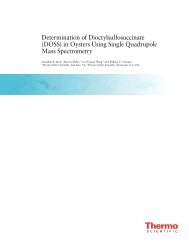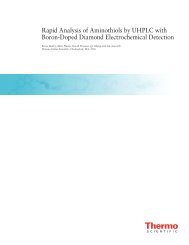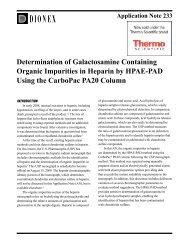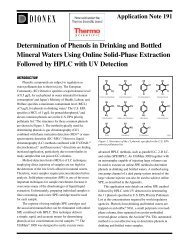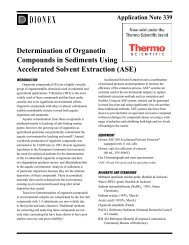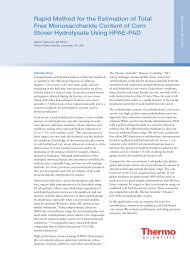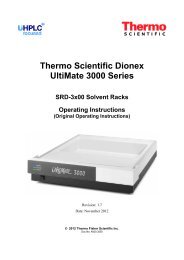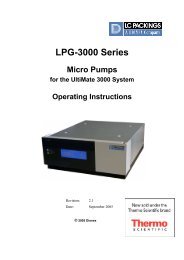Determination of Tartaric Acid in Tolterodine Tartrate Drug ... - Dionex
Determination of Tartaric Acid in Tolterodine Tartrate Drug ... - Dionex
Determination of Tartaric Acid in Tolterodine Tartrate Drug ... - Dionex
You also want an ePaper? Increase the reach of your titles
YUMPU automatically turns print PDFs into web optimized ePapers that Google loves.
<strong>Determ<strong>in</strong>ation</strong> <strong>of</strong> <strong>Tartaric</strong> <strong>Acid</strong> <strong>in</strong><br />
Tolterod<strong>in</strong>e <strong>Tartrate</strong> <strong>Drug</strong> Products by IC<br />
with Suppressed Conductivity Detection<br />
Suparerk Tukkeeree, 1 Chanita Chantarasukon, 1 and Jeff Rohrer2 1 2 Thermo Fisher Scientific, Bangkok, Thailand; Thermo Fisher Scientific, Sunnyvale, CA, USA<br />
Key Words<br />
<strong>Dionex</strong> IonPac AS20 Column, <strong>Dionex</strong> IonPac AS22 Column, Counterion,<br />
<strong>Drug</strong> Product, RFIC, Pharmaceutical<br />
Introduction<br />
Tolterod<strong>in</strong>e is a quaternary ammonium compound used to<br />
treat ur<strong>in</strong>ary <strong>in</strong>cont<strong>in</strong>ence caused by abnormal bladder<br />
contraction. Quaternary ammonium compounds used<br />
as drug substances are typically prepared as salts.<br />
Pharmaceutical companies assay the counterion <strong>in</strong> the<br />
drug substance to ensure it is present at the appropriate<br />
levels. The counterion for tolterod<strong>in</strong>e is tartrate. The<br />
counterion assay can also serve as a check <strong>of</strong> the amount<br />
<strong>of</strong> active pharmaceutical <strong>in</strong>gredient <strong>in</strong> the sample. Ion<br />
chromatography (IC) is <strong>of</strong>ten used for counterion assays. 1<br />
Although an IC assay for tartrate <strong>in</strong> tolterod<strong>in</strong>e tartrate<br />
drug substance that uses carbonate/bicarbonate eluent<br />
has been previously reported, 2 that method requires a<br />
m<strong>in</strong>imum <strong>of</strong> 15 m<strong>in</strong> per analysis (20 m<strong>in</strong> analyses are<br />
shown) and the analyst must manually prepare dilute<br />
sulfuric acid solution for the suppressor. A faster analysis<br />
that requires no preparation <strong>of</strong> eluents or regenerant should<br />
be possible. Shown here is a comparison <strong>of</strong> the separation<br />
and detection <strong>of</strong> tartaric acid us<strong>in</strong>g carbonate/bicarbonate<br />
versus hydroxide eluent.<br />
Goal<br />
To develop a better IC method to determ<strong>in</strong>e tartrate <strong>in</strong><br />
tolterod<strong>in</strong>e drug products<br />
Equipment<br />
• Thermo Scientific <strong>Dionex</strong> ICS-3000 system* <strong>in</strong>clud<strong>in</strong>g:<br />
– DP Dual Gradient Pump<br />
– EG Eluent Generator Module<br />
– DC Detector/Chromatography Module<br />
– CD Conductivity Detector<br />
– AS Autosampler<br />
• Thermo Scientific <strong>Dionex</strong> Chromeleon<br />
Chromatography Data System (CDS) s<strong>of</strong>tware<br />
version 6.80, SR9 or above<br />
*A Thermo Scientific <strong>Dionex</strong> ICS-5000 or any Reagent-Free <br />
IC (RFIC ) system may also be used. If us<strong>in</strong>g a traditional IC<br />
system, eluents must be prepared manually.<br />
Reagents and Standards<br />
• Deionized (DI) water, Type I reagent grade, 18 MΩ-cm<br />
resistivity or better<br />
• <strong>Tartaric</strong> acid ([CHOHCOOH] , 99.5% AR grade,<br />
2<br />
Ajax F<strong>in</strong>echem)<br />
• Sodium carbonate (Na CO ), 0.5 M, P/N 037162<br />
2 3<br />
• Sodium bicarbonate (NaHCO ), 0.5 M, P/N 037163<br />
3<br />
• Thermo Scientific <strong>Dionex</strong> 7-Anion Standard, 50 mL<br />
(P/N 056933)<br />
Application Note 1002
2<br />
Preparation <strong>of</strong> Solutions and Reagents<br />
Na 2 CO 3 , 6 mM/NaHCO 3 , 1.4 mM Eluent<br />
Weigh 1970.4 g DI water <strong>in</strong> a 2 L eluent bottle. Add 24 mL<br />
<strong>of</strong> 0.5 M sodium carbonate and 5.6 mL <strong>of</strong> 0.5 M sodium<br />
bicarbonate to the eluent bottle and mix.<br />
KOH, 20 mM Eluent<br />
The EG module produces the eluent us<strong>in</strong>g the Thermo<br />
Scientific <strong>Dionex</strong> EluGen EGC II KOH cartridge and DI<br />
water supplied by the pump. The eluent concentration<br />
is controlled by Chromeleon CDS s<strong>of</strong>tware. The EG<br />
degasser requires 14 MPa (2000 psi) system backpressure,<br />
which ensures optimal removal <strong>of</strong> electrolytic gas<br />
produced by the EG cartridge. For more <strong>in</strong>formation<br />
about add<strong>in</strong>g system backpressure, refer to the <strong>Dionex</strong><br />
ICS-3000 system operator’s manual (Document No.<br />
065031) or any other RFIC system operator’s manual.<br />
Standard Solutions<br />
<strong>Tartaric</strong> <strong>Acid</strong> Stock Standard Solution, 1000 mg/L<br />
Place 0.1 g tartaric acid <strong>in</strong> a 100 mL volumetric flask,<br />
dissolve with DI water, and br<strong>in</strong>g to volume with DI water.<br />
Work<strong>in</strong>g Standard Solutions<br />
Add the appropriate volumes <strong>of</strong> 1000 mg/L tartaric acid<br />
stock standard solution <strong>in</strong>to separate 100 mL volumetric<br />
flasks and br<strong>in</strong>g to volume with DI water. The volumes<br />
<strong>of</strong> the tartaric acid stock standard solution used for<br />
preparation <strong>of</strong> the work<strong>in</strong>g standard solutions are shown<br />
<strong>in</strong> Table 1.<br />
Table 1. The preparation <strong>of</strong> work<strong>in</strong>g standard solutions<br />
Level<br />
Concentration<br />
(mg/L)<br />
Volume <strong>of</strong> 1000 mg/L <strong>Tartaric</strong><br />
<strong>Acid</strong> Stock Standard Solution<br />
for 100 mL Preparation (mL)<br />
1 5 0.50<br />
2 10 1.00<br />
3 15 1.50<br />
4 20 2.00<br />
Sample Preparation<br />
The drug sample was purchased from a local pharmacy.<br />
Five capsules conta<strong>in</strong><strong>in</strong>g tolterod<strong>in</strong>e tartrate were each<br />
opened and weighed to determ<strong>in</strong>e the average weight <strong>of</strong><br />
a s<strong>in</strong>gle capsule. This weight was used to describe the<br />
sample preparation below. The average weight and the<br />
weight <strong>of</strong> each sample are shown <strong>in</strong> Table 2.<br />
After weigh<strong>in</strong>g, gr<strong>in</strong>d contents to a f<strong>in</strong>e powder. Place<br />
0.184 g <strong>of</strong> the f<strong>in</strong>e sample powder <strong>in</strong> a 100 mL volumetric<br />
flask. Add 50 mL <strong>of</strong> DI water and place the volumetric<br />
flask <strong>in</strong> an ultrasonic bath for 5 m<strong>in</strong>. After sonication,<br />
br<strong>in</strong>g to volume with DI water. Mix and filter with a 0.45 µm<br />
syr<strong>in</strong>ge filter before <strong>in</strong>ject<strong>in</strong>g the sample. The label <strong>of</strong><br />
the drug product shows a nom<strong>in</strong>al value <strong>of</strong> 4 mg <strong>of</strong><br />
tolterod<strong>in</strong>e tartrate per capsule. Based on the label and<br />
sample preparation process, the concentration <strong>of</strong> tartrate<br />
after sample preparation will be 12.6 mg/L. The calculated<br />
concentration <strong>of</strong> tartrate is used to determ<strong>in</strong>e the amount<br />
<strong>of</strong> tolterod<strong>in</strong>e tartrate <strong>in</strong> the capsule because the molar<br />
ratio <strong>of</strong> tolterod<strong>in</strong>e to tartrate is 1:1.<br />
Prepare the spiked sample <strong>in</strong> the same manner, with 0.4 mL <strong>of</strong><br />
1000 mg/L tartaric acid added to the sample before dissolution.<br />
Table 2. Weight <strong>of</strong> drug sample <strong>in</strong> each capsule<br />
Capsule No. (g/Capsule)<br />
1 0.178<br />
2 0.182<br />
3 0.189<br />
4 0.186<br />
5 0.184<br />
Average 0.184<br />
Chromatographic Conditions<br />
Condition 1<br />
Column: Thermo Scientific <strong>Dionex</strong> IonPac AS20 Analytical,<br />
4 × 250 mm (P/N 063148)<br />
Guard Column: <strong>Dionex</strong> IonPac AG20 Guard,<br />
4 × 50 mm (P/N 063154)<br />
Eluent Source: <strong>Dionex</strong> EluGen EGC II KOH (P/N 058900) with<br />
Thermo Scientific <strong>Dionex</strong> CR-ATC<br />
Cont<strong>in</strong>uously Regenerated Anion Trap Column<br />
(P/N 060477)<br />
Eluent: 20 mM KOH<br />
Flow Rate: 1 mL/m<strong>in</strong><br />
Pressure: ~2100 psi<br />
Inj. Volume: 10 µL<br />
Column Temp.: 30 °C<br />
Detection: Suppressed conductivity<br />
Suppressor: Thermo Scientific <strong>Dionex</strong> ASRS 300 Anion<br />
Self-Regenerat<strong>in</strong>g Suppressor, 4 mm<br />
(P/N 064554), recycle mode, current 50 mA<br />
Condition 2<br />
Column: <strong>Dionex</strong> IonPac AS22 Analytical, 4 × 250 mm<br />
(P/N 064141)<br />
Guard Column: <strong>Dionex</strong> IonPac AG22 Guard, 4 × 50 mm<br />
(P/N 064139)<br />
Eluent: 6 mM Na CO /1.4 mM NaHCO 2 3 3<br />
Flow Rate: 1.2 mL/m<strong>in</strong><br />
Pressure: ~1850 psi<br />
Inj. Volume: 10 µL<br />
Column Temp.: 30 oC Detection: Suppressed conductivity<br />
Suppressor: <strong>Dionex</strong> ASRS 300, 4 mm (P/N 064554),<br />
recycle mode, current 40 mA
Results and Discussion<br />
Separation<br />
Separation and drug product analyses are presented us<strong>in</strong>g<br />
both hydroxide and carbonate/bicarbonate eluents. An<br />
EG module was used for separation with the hydroxide<br />
eluent, and manual eluent preparation was used for<br />
separation with the carbonate/bicarbonate eluent. Us<strong>in</strong>g<br />
the EG module or manual eluent preparation are options<br />
for both methods; however, EG-based methods will<br />
typically provide superior reproducibility.<br />
The <strong>Dionex</strong> IonPac AS20 and AS22 columns were used<br />
with hydroxide and carbonate/bicarbonate eluents,<br />
respectively, for the determ<strong>in</strong>ation <strong>of</strong> tartaric acid <strong>in</strong><br />
tolterod<strong>in</strong>e tartrate. Figure 1 shows that tartrate (tartaric<br />
acid) is easily resolved from seven common anions us<strong>in</strong>g a<br />
hydroxide gradient with the <strong>Dionex</strong> IonPac AS20 column.<br />
The method first elutes six <strong>of</strong> the seven anions along with<br />
tartrate, after which the eluent strength is <strong>in</strong>creased to<br />
elute the trivalent phosphate. Application <strong>of</strong> this method<br />
to the drug sample (Figure 1, trace B) showed no<br />
significant amount <strong>of</strong> phosphate <strong>in</strong> the sample; therefore,<br />
the method was simplified to an isocratic method us<strong>in</strong>g<br />
20 mM KOH (Figure 2). These chromatographic<br />
conditions are referred to as Condition 1.<br />
Figure 3 shows separation <strong>of</strong> tartrate and seven common<br />
anions us<strong>in</strong>g isocratic elution with a carbonate/<br />
bicarbonate eluent on the <strong>Dionex</strong> IonPac AS22 column.<br />
Phosphate is divalent at this pH (8 to 9) and therefore<br />
elutes before tartrate. These chromatographic conditions<br />
are referred to as Condition 2. This method requires<br />
12 m<strong>in</strong> per analysis and can be accelerated us<strong>in</strong>g the<br />
<strong>Dionex</strong> IonPac AS22-Fast column, which is designed for<br />
fast, relatively simple separations.<br />
12.0<br />
µS<br />
0.0<br />
B<br />
A<br />
1<br />
Column: <strong>Dionex</strong> IonPac AS20 Analytical, 4 × 250 mm<br />
<strong>Dionex</strong> IonPac AG20 Guard, 4 × 50 mm<br />
Eluent Source: <strong>Dionex</strong> EGC II KOH with CR-ATC<br />
Eluent: Time Eluent Conc (mM)<br />
-5.0 20<br />
8.0 20<br />
9.0 40<br />
13.9 40<br />
14.0 20<br />
Flow Rate: 1.0 mL/m<strong>in</strong><br />
Inj. Volume: 10 µL<br />
Temperature: 30 °C<br />
Detection: Suppressed conductivity, <strong>Dionex</strong> ASRS 300,<br />
4 mm, recycle mode, 50 mA<br />
Sample: A. <strong>Dionex</strong> 7-Anion Standard<br />
B. Sample<br />
2<br />
3<br />
5<br />
4 6<br />
-2.0<br />
0.0 2.5 5.0 7.5<br />
M<strong>in</strong>utes<br />
10.0 12.5 14.0<br />
Figure 1. Overlay <strong>of</strong> chromatograms <strong>of</strong> gradient elution <strong>of</strong> the<br />
<strong>Dionex</strong> 7-Anion Standard and sample us<strong>in</strong>g the <strong>Dionex</strong> IonPac AS20<br />
column and hydroxide eluent<br />
1<br />
7<br />
Peaks:<br />
A B<br />
1. Fluoride <strong>Tartrate</strong><br />
2. Chloride<br />
3. Nitrite<br />
4. Bromide<br />
5. Nitrate<br />
6. Sulfate<br />
7. Phosphate<br />
12<br />
µS<br />
0<br />
B<br />
A<br />
1<br />
Column: <strong>Dionex</strong> IonPac AS20 Analytical, 4 × 250 mm<br />
<strong>Dionex</strong> IonPac AG20 Guard, 4 × 50 mm<br />
Eluent Source: <strong>Dionex</strong> EGC II KOH with CR-ATC<br />
Eluent: 20 mM<br />
Flow Rate: 1.0 mL/m<strong>in</strong><br />
Inj. Volume: 10 µL<br />
Temperature: 30 °C<br />
Detection: Suppressed conductivity,<br />
<strong>Dionex</strong> ASRS 300, 4 mm,<br />
recycle mode, 50 mA<br />
Sample: A. <strong>Dionex</strong> 7-Anion Standard<br />
B. Sample<br />
2<br />
-2<br />
0 1 2 3 4 5<br />
M<strong>in</strong>utes<br />
6 7 8 9 10<br />
3<br />
4<br />
A B<br />
1. Fluoride <strong>Tartrate</strong><br />
2. Chloride<br />
3. Nitrite<br />
4. Bromide<br />
5. Nitrate<br />
6. Sulfate<br />
Figure 2. Overlay <strong>of</strong> chromatograms <strong>of</strong> the <strong>Dionex</strong> 7-Anion Standard and sample<br />
us<strong>in</strong>g Condition 1<br />
4.0<br />
µS<br />
0.0<br />
B<br />
A<br />
1<br />
2<br />
Figure 3. Overlay <strong>of</strong> chromatograms <strong>of</strong> the <strong>Dionex</strong> 7-Anion Standard and sample<br />
us<strong>in</strong>g Condition 2<br />
5<br />
6<br />
1<br />
Peaks:<br />
Column: <strong>Dionex</strong> IonPac AS22 Analytical, 4 × 250 mm<br />
<strong>Dionex</strong> IonPac AG22 Guard, 4 × 50 mm<br />
Eluent: 6 mM Na 2 CO 3 /1.4 mM NaHCO 3<br />
Flow Rate: 1.2 mL/m<strong>in</strong><br />
Inj. Volume: 10 µL<br />
Column Temp.: 30 °C<br />
Detection: Suppressed conductivity,<br />
<strong>Dionex</strong> ASRS 300, 4 mm,<br />
recycle mode, 40 mA<br />
3<br />
Sample: A. <strong>Dionex</strong> 7-Anion Standard<br />
B. Sample<br />
4 5<br />
-1.0<br />
0.0 1.3 2.5 3.8 5.0 6.3 7.5 8.8 10.0 12.0<br />
M<strong>in</strong>utes<br />
6<br />
7<br />
1<br />
Peaks:<br />
A B<br />
1. Fluoride <strong>Tartrate</strong><br />
2. Chloride<br />
3. Nitrite<br />
4. Bromide<br />
5. Nitrate<br />
6. Sulfate<br />
7. Phosphate<br />
3
4 Method Calibration<br />
The methods were calibrated before sample analysis us<strong>in</strong>g<br />
the same work<strong>in</strong>g standards. Both methods demonstrated<br />
a l<strong>in</strong>ear relationship between peak area and concentration.<br />
The coefficients <strong>of</strong> determ<strong>in</strong>ation (r 2 ) obta<strong>in</strong>ed from<br />
Conditions 1 and 2 were 0.9996 and 0.9990, respectively.<br />
Method calibration results and work<strong>in</strong>g standard<br />
concentrations are shown <strong>in</strong> Table 3.<br />
Sample Analysis<br />
The sample was a drug product (<strong>in</strong> capsule form)<br />
conta<strong>in</strong><strong>in</strong>g tolterod<strong>in</strong>e tartrate. Each capsule was labeled<br />
as conta<strong>in</strong><strong>in</strong>g 4 mg <strong>of</strong> tolterod<strong>in</strong>e tartrate. After sample<br />
preparation, five <strong>in</strong>jections <strong>of</strong> each sample were made for<br />
each <strong>of</strong> the two chromatographic conditions to determ<strong>in</strong>e<br />
the amount <strong>of</strong> tartrate <strong>in</strong> each sample.<br />
Table 4 shows the results <strong>of</strong> these analyses and Figures<br />
4 and 5 show representative sample chromatograms.<br />
Table 4 shows good accuracy and reproducibility for both<br />
methods, with tartrate at 98.4% and 96.0% <strong>of</strong> the label<br />
value, respectively. Method accuracy was also determ<strong>in</strong>ed<br />
by spik<strong>in</strong>g a known amount <strong>of</strong> tartaric acid <strong>in</strong>to the<br />
sample before sample preparation to yield an additional<br />
4 mg/L after sample preparation. The recovery results <strong>of</strong><br />
100% and 103% for Conditions 1 and 2, respectively,<br />
confirm accuracy for both methods. These results are<br />
also shown <strong>in</strong> Table 4. Interest<strong>in</strong>gly, neither the U.S. nor<br />
the European Pharmacopeias conta<strong>in</strong>s a monograph to<br />
<strong>in</strong>struct on the assay <strong>of</strong> tolterod<strong>in</strong>e tartrate.<br />
Table 3. Work<strong>in</strong>g standard concentrations and calibration results for Conditions 1 and 2<br />
Condition 1<br />
Analyte<br />
Level 1<br />
Concentration (mg/L)<br />
Level 2 Level 3 Level 4 Po<strong>in</strong>ts r<br />
Results<br />
2 Offset Slope<br />
<strong>Tartaric</strong> acid 5 10 15 20 12 0.9996 0.0061 0.0588<br />
Condition 2<br />
Analyte<br />
Level 1<br />
Concentration (mg/L)<br />
Level 2 Level 3 Level 4 Po<strong>in</strong>ts r<br />
Results<br />
2 Offset Slope<br />
<strong>Tartaric</strong> acid 5 10 15 20 12 0.9990 -0.0010 0.0232<br />
Table 4. <strong>Determ<strong>in</strong>ation</strong> <strong>of</strong> tartrate <strong>in</strong> encapsulated drug samples, along with spiked sample recovery results<br />
Injection No.<br />
-1<br />
0 1 2 3 4 5<br />
M<strong>in</strong>utes<br />
6 7 8 9 10<br />
Figure 4. Overlay <strong>of</strong> chromatograms <strong>of</strong> a sample and spiked sample obta<strong>in</strong>ed<br />
us<strong>in</strong>g Condition 1<br />
Condition 1 Condition 2<br />
Sample (mg/L) Spiked Sample (mg/L) Sample (mg/L) Spiked Sample (mg/L)<br />
1 12.4 16.5 12.1 16.3<br />
2 12.3 16.4 12.1 16.3<br />
3 12.3 16.3 12.0 16.1<br />
4 12.4 16.4 12.2 16.2<br />
5 12.4 16.5 12.0 16.3<br />
Average 12.4 16.4 12.1 16.2<br />
RSD 0.29 0.56 0.74 0.49<br />
Assay (%) 98.4% — 96.0% —<br />
6<br />
µS<br />
0<br />
Column: <strong>Dionex</strong> IonPac AS20 Analytical, 4 × 250 mm<br />
<strong>Dionex</strong> IonPac AG20 Guard, 4 × 50 mm<br />
Eluent Source: <strong>Dionex</strong> EGC II KOH with CR-ATC<br />
Eluent: 20 mM KOH<br />
Flow Rate: 1.0 mL/m<strong>in</strong><br />
Inj. Volume: 10 µL<br />
Temperature: 30 °C<br />
Detection: Suppressed conductivity,<br />
<strong>Dionex</strong> ASRS 300, 4 mm,<br />
recycle mode, 50 mA<br />
Sample: A. Sample<br />
B. Spiked sample<br />
Peaks: A B (mg/L)<br />
1. <strong>Tartrate</strong> 12.4 16.4<br />
B<br />
A<br />
1
2.0<br />
µS<br />
-0.0<br />
Column: <strong>Dionex</strong> IonPac AS22 Analytical, 4 × 250 mm<br />
<strong>Dionex</strong> IonPac AG22 Guard, 4 × 50 mm<br />
Eluent:<br />
Flow Rate:<br />
Inj. Volume:<br />
6 mM Na CO /1.4 mM NaHCO 2 3 3<br />
1.2 mL/m<strong>in</strong><br />
10 µL<br />
1<br />
Temperature: 30 °C<br />
Detection: Suppressed conductivity,<br />
<strong>Dionex</strong> ASRS 300, 4 mm,<br />
recycle mode, 40 mA<br />
Sample: A. Sample<br />
B. Spiked sample<br />
Peaks: A B (mg/L)<br />
1. <strong>Tartrate</strong> 12.1 16.2<br />
B<br />
A<br />
-0.5<br />
0.0 1.3 2.5 3.8 5.0 6.3 7.5 8.8 10.0 12.0<br />
M<strong>in</strong>utes<br />
Figure 5. Overlay <strong>of</strong> chromatograms <strong>of</strong> a sample and spiked sample obta<strong>in</strong>ed<br />
us<strong>in</strong>g Condition 2<br />
www.thermoscientific.com<br />
©2012 Thermo Fisher Scientific Inc. All rights reserved. ISO is a trademark <strong>of</strong> the International Standards Organization.<br />
All other trademarks are the property <strong>of</strong> Thermo Fisher Scientific Inc. and its subsidiaries. Specifications, terms and pric<strong>in</strong>g are<br />
subject to change. Not all products are available <strong>in</strong> all countries. Please consult your local sales representative for details.<br />
U.S./Canada (847) 295 7500<br />
Australia (61) 2 9420 5233<br />
Austria (43) 1 616 51 25<br />
Benelux (31) 20 683 9768<br />
(32) 3 353 42 94<br />
Brazil (55) 11 3731 5140<br />
Ch<strong>in</strong>a (852) 2428 3282<br />
Denmark (45) 36 36 90 90<br />
France (33) 1 39 30 01 10<br />
Germany (49) 6126 991 0<br />
1<br />
India (91) 22 2764 2735<br />
Ireland (353) 1 644 0064<br />
Italy (39) 02 51 62 1267<br />
Japan (81) 6 6885 1213<br />
Korea (82) 2 2653 2580<br />
Conclusion<br />
The work shown here demonstrates two IC methods<br />
that are accurate and reproducible for determ<strong>in</strong>ation <strong>of</strong><br />
tartrate <strong>in</strong> an encapsulated drug product conta<strong>in</strong><strong>in</strong>g the<br />
drug substance tolterod<strong>in</strong>e tartrate. One method uses<br />
eluent generation and the other uses manual eluent<br />
preparation; however, both methods can be executed<br />
us<strong>in</strong>g either method <strong>of</strong> eluent preparation. Both methods<br />
use an electrolytic suppressor, so the time and labor<br />
associated with prepar<strong>in</strong>g dilute sulfuric acid regenerant<br />
are elim<strong>in</strong>ated. The RFIC method demonstrates improved<br />
accuracy and productivity because both eluent and<br />
regenerant are prepared automatically, elim<strong>in</strong>at<strong>in</strong>g the<br />
time and effort required to manually prepare these<br />
reagents while also reduc<strong>in</strong>g the possibility <strong>of</strong> errors and<br />
contam<strong>in</strong>ation. The RFIC system method requires only<br />
10 m<strong>in</strong> per analysis. The second method uses a carbonate/<br />
bicarbonate eluent and has an analysis time <strong>of</strong> 12 m<strong>in</strong>.<br />
References<br />
1. <strong>Dionex</strong> (now part <strong>of</strong> Thermo Scientific) Application<br />
Note 190: <strong>Determ<strong>in</strong>ation</strong> <strong>of</strong> Sulfate Counter Ion and<br />
Anionic Impurities <strong>in</strong> Am<strong>in</strong>oglycoside <strong>Drug</strong> Substances<br />
by Ion Chromatography with Suppressed Conductivity<br />
Detection. LPN1946, Sunnyvale, CA, 2007. [Onl<strong>in</strong>e]<br />
www.dionex.com/en-us/webdocs/61810-AN190_IC_<br />
counter_ions_am<strong>in</strong>oglycosides_28Aug2007_LPN1946.<br />
pdf (accessed Feb. 28, 2012).<br />
2. Deshpande, G.R.; Rao, B.M.; Someswararao, N.<br />
Quantitative <strong>Determ<strong>in</strong>ation</strong> <strong>of</strong> <strong>Tartaric</strong> <strong>Acid</strong> <strong>in</strong><br />
Tolterod<strong>in</strong>e <strong>Tartrate</strong> by Ion Chromatography Us<strong>in</strong>g<br />
Conductivity Detection. RASAYAN J. Chem. 2009, 2,<br />
101–107.<br />
Thermo Scientific <strong>Dionex</strong><br />
products are, designed,<br />
developed, and manufactured<br />
under an ISO 9001 Quality System.<br />
S<strong>in</strong>gapore (65) 6289 1190<br />
Sweden (46) 8 473 3380<br />
Switzerland (41) 62 205 9966<br />
Taiwan (886) 2 8751 6655<br />
United K<strong>in</strong>gdom (44) 1276 691722<br />
AN1002_E 05/12S LPN3065<br />
Application Note 1002




